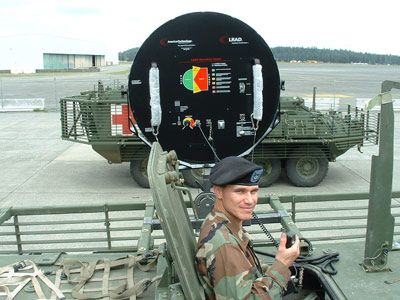
wheel it back, selector
I’m going to take a page from MBQ’s playbook and reblog a rather interesting post on sound cannons (aka LRADs, Long Range Acoustic Devices™) by fellow ethnomusicoloblogger, Ben Tausig, who is writing a very engaging blog about the “politics of sound.”
I find Ben’s thoughts particularly revealing against the backdrop of recent conversations here about frequency & power — in particular, Kode9’s argument that serious bass can remind us that we’re “not self-enclosed individuals but permeable membranes through which forcefields can pass.” Or, as Ben notes (see the list below), in the case of certain levels/uses of sound, not pass —
LRADs operate in the threshold between normal listening, where vibration is mild enough that we experience sound as essentially immaterial, and where we can readily pay attention to communicative and aesthetic content (music, language, texture), and extreme sonic exposure, where vibration is felt as a force throughout the body. The sound cannon is far enough along this spectrum that we react involuntarily to its painful volume, but not so far along that we lose life or limb. It’s pretty brilliant, in a mad scientist kind of way.
In any case, it’s fascinating/macabre to consider what various sound levels can to us physically. The hardware manufacturer makeitlouder.com has a whole chart.
(Decibels measure the intensity of a sound wave. They do not measure frequency, so for example knowing that a conversation occurs around 50 dbs does not tell us whether the voices are high or low.)
Here are some choice selections:
13 – Ordinary light bulb hum
30 – Totally quiet nighttime in desert – impossible near city
40 – A whisper
60 – Normal conversation
100 – House or car stereo at maximum volume
116 – Human body begins to perceive vibration at low frequencies (imagine standing in front of a speaker at a concert, for example)
125 – Drum at the moment of being hit
127 – Tinnitus sets in
128 – Human hair will begin to vibrate perceptibly
132 – Eardrum flex becomes noticeable
133 – Gunshot at ear level
135 – The air begins to cool from expansion
137 – The entire human body vibrates
140 – Extreme damage to hearing no matter how short the exposure (this, by the way, is how loud the LRAD can be set)
141 – The human body experiences nausea
142 – Chest pounding is intense
143 – Human body feels as if “someone just football tackled your chest”
145 – Human vision begins to vibrate
153 – Human throat vibrates so hard it is almost impossible to swallow
163 – Minimum glassbreaking level
172 – Fog is created
175 – Equivalent to a quarter stick of dynamite
180 – Damage to structures is catastrophic
186.1 – Equivalent to a pound of TNT at a distance of 10 feet
202 – Immediate human death
220 – Equivalent to the largest bomb used in WWII
257 – Equivalent to 1 megaton nuclear bomb
See also: wordthecat on “sensory weapons” and, of course, Kode9’s forthcoming
Fascinating list. Wonder how they tested all the higher numbers. And on whom.
IK
Good point, IK. Perhaps the War on Terror® has afforded some research opportunities?
Thats rather terrifying.
Hey! some time ago i found a nice scientific investigation (1999) by J. Altmann called Acoustic Weapons.. the REAL DEAL :D lowdown & download over here
Was just at the Love Fest/Love Parade/LovEvolution party in SF last weekend. I seem to value my hearing more than 93% of the other participants. Yes, I was the guy wearing ear plugs. I had people (a cute girl) literally saying “take those out”, to which I said, “no”. My whole body was vibrating as I went all out at the dnb truck for 5 hours. Even the MC was calling out to “the folks gonna have ringing in their ears all tomorrow”… Seriously? Is the ringing threshold equivalent to the Walmart purchase threshold? I like big sounds, mostly bass, but to ruin one’s only set of ears for a f’in dance party seems counter-intuitive to me. I want to enjoy the next one equally.
Check out this video for details of whalers using LRADs against protestors:
http://www.youtube.com/watch?v=ocxDKf1E_Hg&feature=fvhl